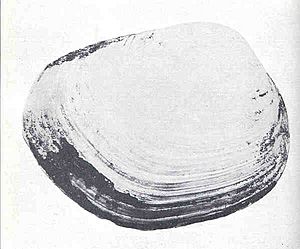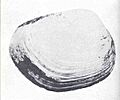Tresus nuttallii facts for kids
Quick facts for kids Tresus nuttallii |
|
|---|---|
 |
|
| Scientific classification |
The Pacific gaper (scientific name: Tresus nuttallii) is a type of saltwater clam. It's a marine bivalve mollusk that lives in the ocean. This clam is also sometimes called a horse clam. Another similar species, Tresus capax, also shares the name "horse clam."
Both the Pacific gaper and the fat gaper (T. capax) are a bit like the famous Geoduck clam, but they are smaller. Their shells can grow up to 20 centimeters (about 8 inches) long, and they can weigh up to 1.8 kilograms (about 4 pounds).
These clams are called "gapers" because their shells don't close all the way around their long tube, called a siphon. This siphon sticks out, just like with geoduck clams. They can't pull their siphon completely inside their shell, but it's not as big as a geoduck's siphon.
Contents
How to Spot a Pacific Gaper
It can be tricky to tell the Pacific gaper (T. nuttallii) apart from the fat gaper (T. capax). Here's how:
- The Pacific gaper's shell is usually longer and narrower.
- It also has bigger "siphonal plates." These are hard, horny plates at the end of the siphon. Sometimes, you might even see tiny algae or barnacles growing on them!
Where Pacific Gapers Live and How They Live
Pacific gapers live in the lower intertidal zone, which is the area of the beach that is covered and uncovered by tides. They can also be found in deeper waters, up to 13-15 meters (about 50-60 feet) deep.
They like to bury themselves in sand, mud, and gravel. They usually dig down about 30-41 centimeters (12-16 inches). This makes them much easier to dig up than geoducks, which bury themselves much deeper! Other popular clams like butter clams and littleneck clams also like these types of sandy or muddy bottoms. Because of this, people sometimes dig up horse clams by accident when they are looking for other clams.
Clams and Crabs: A Team Effort
Horse clams often share their home with tiny pea crabs. These crabs, usually a male and female pair, enter through the clam's large siphon. They live inside the clam's shell, but they don't harm the clam. It's a type of relationship called commensalism, where one benefits and the other isn't affected. You can easily see these little crabs when you open a clam. The clam meat is still good to eat and makes great chowder!
Life Cycle and Reproduction
Like geoducks, horse clams release their eggs and sperm into the water to reproduce. This is called "broadcast spawning." Pacific gapers (T. nuttalii) usually spawn in the summer, while fat gapers (T. capax) spawn in the winter.
Digging for Clams: Rules and Safety
People have been digging for horse clams for a very long time, especially Native Americans who lived along the Pacific Ocean coast. They valued these clams because they were big, easy to find, and plentiful. Today, geoducks are more popular, but horse clams are still a good catch.
If you want to dig for clams, it's important to know the rules. Organizations like the Washington State Department of Fish and Wildlife set limits on how many clams you can dig and how big they need to be. This helps make sure there are enough clams for the future.
It's also very important to check if the beach is safe for digging. Sometimes, beaches are closed because of things like "biotoxins" that can make shellfish unsafe to eat. You can usually find current information on local health department websites.
Being a Responsible Clam Digger
Some clam diggers don't find horse clams as tasty as other types of clams. So, during clamming season, you might see horse clams left on the beach. Their shells are quite fragile. If you dig one up and don't plan to keep it, it's super important not to damage it.
Adult clams cannot rebury themselves once they are out of the sand. They need the pressure of the surrounding sand to stay healthy and move around. A responsible clam digger will carefully rebury any horse clams they don't keep, putting them back at the same depth they were found. This helps them survive!
Images for kids


